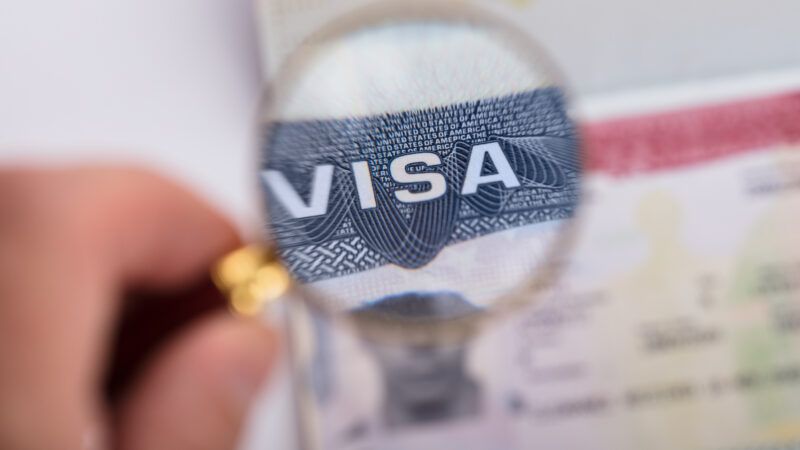Two Years Into the Pandemic, the U.S. Is Still Struggling To Issue Visas
The government has had ample time to figure out how to provide standard visa services in the face of COVID-19, but it’s come up short.

As the United States first began to tackle COVID-19 in March 2020, cross-border movement suffered. Immigration and travel ground to a halt. Now, nearly two years into the pandemic, issues at U.S. embassies and consulates are still preventing tourists, students, and temporary workers from getting their visas.
Since the beginning of the pandemic, COVID-related closures and staffing issues in responsible agencies have hobbled legal travel and immigration to the U.S. "As of mid-October, 60 percent of consulates remained fully or partially closed to anything other than emergency nonimmigrant visa appointments, and 40 percent are completely closed to non-emergency nonimmigrant visa appointments," noted Cato Institute immigration research fellow David J. Bier. Bier wrote that only 2 percent of consulates had fully reopened between August and October 2021, despite vaccines being available to all consular officers since May 2021.
Operations are still bleak in 2022. In Toronto, the current wait time for a nonimmigrant visa appointment (excluding visitor and student visas) is 379 days; in Istanbul, 306 days; and in Santiago, 209 days. Wait times for visitor visas are often far worse—running as high as 595 days in Istanbul, 521 days in Mexico City, 598 days in Manila, and available only in emergency cases in Mumbai, among other cities.
Though the U.S. reopened its borders to certain travelers in November 2021, limited visa processing has kept many visa holders trapped in the U.S, fearing that they may not be allowed to reenter the country if they return home to renew their visas. Foreign citizens who hold nonimmigrant U.S. visas may renew their employment authorizations from American soil, but must renew their visas from abroad.
"People have been afraid to travel because they know that if they leave, and they don't have a current visa, that they could be stuck for months on end, almost indefinitely, without being able to get back into the U.S.," immigration lawyer Greg Siskind told Roll Call in December. "I'm still advising people: Don't travel, unless you're prepared to be working remotely for a year."
On December 22, Reps. Peter Meijer (R–Mich.) and Darren Soto (D–Fla.) penned a letter calling on the Biden administration to fully restore visa processing to pre-pandemic levels. An additional 86 members of Congress joined Meijer and Soto in condemning delays for seasonal and short-term workers, as well as those waiting on tourist visas.
"Limited visa processing capacity and extended wait-times are a legacy of measures taken in the early days of the pandemic that are no longer appropriate or necessary as testing and vaccines become more widely available," wrote the lawmakers. As of the letter's writing in late December, the lawmakers noted that 60 percent of U.S. embassies and consulates were partially or completely closed for visa processing. "Just 95 of 237 visa processing sites [were] fully operational," according to The Detroit News.
Permanent visa applicants aren't faring much better. This month, the State Department reported a current backlog of 439,373 immigrant visa applicants whose cases were "documentarily complete" and still needed visa appointments, having only scheduled 26,605 appointments for January. The State Department notes that in 2019, "60,866 applicants were pending the scheduling of an interview each month" on average. In December 2021, U.S. Citizenship and Immigration Services was found to have a backlog of 3.8 million cases.
In an attempt to alleviate current visa processing issues, the State Department announced last month that it would waive in-person interviews for nearly a dozen visa categories, including those for "students, temporary agricultural and non-agricultural workers, student exchange visitors…and entertainers." The same week, the Department of Homeland Security said that it would add 20,000 H-2B visas to the cap for fiscal year 2022—a first-ever supplement to the nonimmigrant nonagricultural worker visa program.
These fixes are important and will help heal some of the many forms of international movement that have suffered during the pandemic. Still, legal immigration to the U.S. has completely cratered, officials continue to lean into long-disproven measures that tie border crossings to COVID spread, and routine visa services have stagnated. With vaccines now widely available and nearly two years of the pandemic behind us, it's absurd that visa-issuing officials are still using COVID-19 as an excuse for their inefficiencies.
